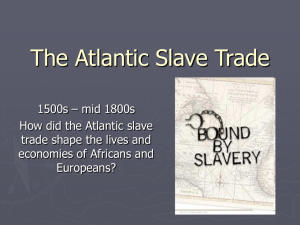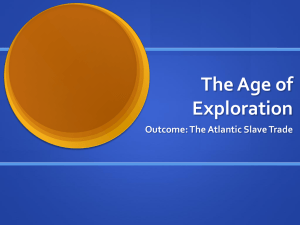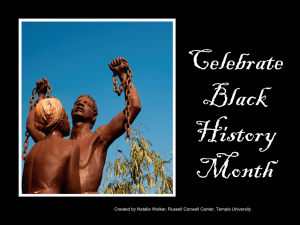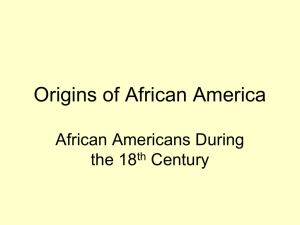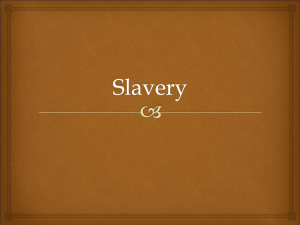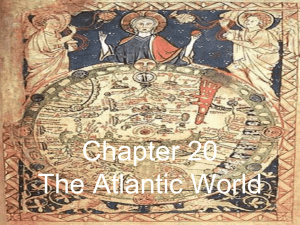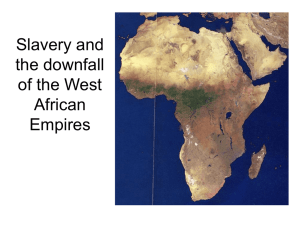The Atlantic Slave Trade
advertisement
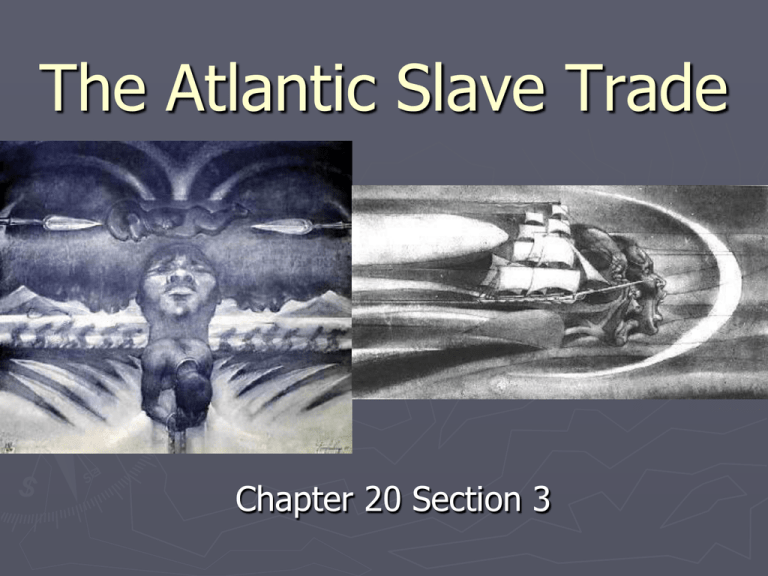
The Atlantic Slave Trade Chapter 20 Section 3 I. Causes of African slavery A. Slavery already existed in Africa different than slavery in Americas 1. Slavery similar to serfdom slavery ended after certain # of years in servitude 2. Slaves could marry, own property, and even own slaves 3. Slavery not hereditary 4. Slavery lacked racism B. Spread of Islam in 7th c. led to increase in slavery & slave trade 1. Justified by belief that a non-Muslim could be bought & sold as slaves 2. Slaves had some legal rights & opportunity for social mobility 3. Slaves could escape bondage i.e. by marrying into family they served C. Demand for Africans increased with the colonization of the Americas 1. Europeans saw advantages of using Africans in the Americas a. Exposure & immunity to European diseases b. Experience in farming c. Less likely to escape did not know new land d. Skin color made easier to identify & catch escapees II. Atlantic slave trade became massive enterprise A. By the time it ended in 1870, nearly 10-12 million Africans were enslaved B. Spain took the lead in importing Africans 1. Slaves worked on plantations, gold & silver mines C. Portuguese surpassed Spanish in slave trade 1. Brazil dominated sugar market increased demand for cheap labor 2. More than 40% of Africans in slave trade went to Brazil in 17th c. D. England became leading carrier of enslaved Africans 1. Transported nearly 1.7 million Africans to their colonies in West Indies 2. 1672 – King of England chartered the Royal African Company 3. 1698 – English Parliament ruled that any British subject could own slaves III. African cooperation & resistance A. African rulers & merchants played willing role in African slave trade captured Africans to be enslaved 1. European traders waited in ports on coast of Africa 2. African slaves were traded with Europeans in exchange for gold, guns, etc. B. Some African rulers voiced their opposition 1. Lured by profits, rulers continued to participate 2. Merchants found new trade routes to avoid oppositional rulers IV. The Journey A. The Triangular Trade – transatlantic trading network 1. Europeans transported manufactured goods to the west coast of Africa 2. Goods exchanged for captured Africans 3. Africans brought across Atlantic & sold in West Indies 4. Merchants brought sugar, coffee, & tobacco from West Indies back to Europe 4 1 3 2 B. The Middle Passage the voyage that brought captured Africans to New World 1. Africans packed into dark holds of large ships 2. Africans endured whippings & beatings from merchants 3. Diseases swept through vessel millions died 4. Many Africans committed suicide by drowning 5. Nearly 20% of Africans aboard each ship perished during trip Plan of a Slave Ship V. Slavery in the Americas A. Harsh life upon arrival in Americas 1. Sold to highest bidder worked in mines, fields, or as domestic servants 2. Little food, lived in small huts 3. Worked long days & suffered beatings 4. Lifelong & hereditary condition B. Resistance & rebellion 1. Africans developed way of life based on their cultural heritage a. Musical traditions & stories of ancestors 2. Resisted by making themselves less productive broke tools, moved slowly 3. Thousands ran away 4. Open revolts numerous uprisings VI. Results of slave trade A. Effects in Africa 1. Numerous cultures lost generations of their fittest members 2. Families torn apart & never reunited 3. Introduced guns to the continent of Africa B. Effects in the Americas 1. Slaves contributed greatly to economic & cultural development of Americas a. Survival of colonies depended on their labor b. Africans brought their expertise in agriculture c. Brought their art, music, religion, & food to influence American societies Olaudah Equiano - Kidnapped & sold into slavery as a child - Eventually earned price of his freedom by careful trading & saving - Later became involved in movement to abolish the slave trade - His narrative describes the horrific Middle Passage & experiences of slaves Published “The Interesting Narrative on the Life of Olaudah Equiano” in 1789
